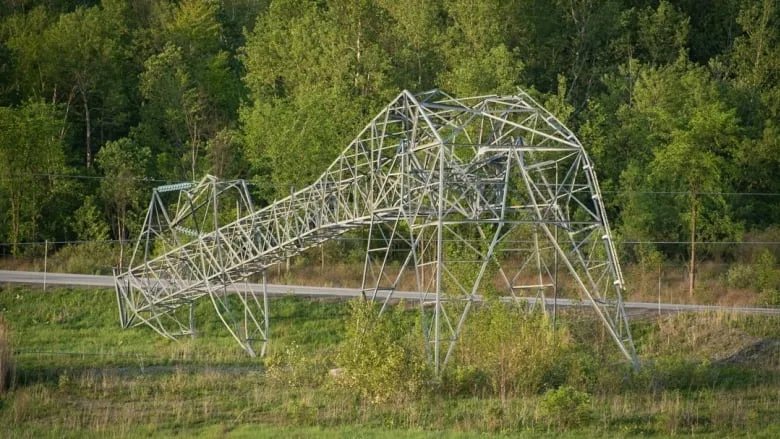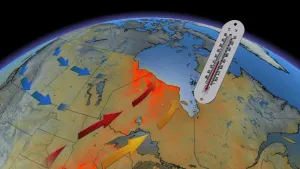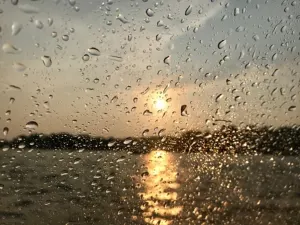
'As bad as it gets': Why what hit Ottawa was worse than the ice storm, tornadoes
Four massive steel transmission towers that sit crumpled near Ottawa hint at the scope of the challenge facing crews in the wake of Saturday's massive storm, as they work to restore power to tens of thousands of residents.
Those Hydro One towers, or what's left of them, also stand as proof just how ferocious the winds that battered the region were — and how vulnerable the city's power grid can be.
They're evidence of a weather event that Bryce Conrad, CEO of Hydro Ottawa, said was worse than the ice storm of 1998 and the tornadoes that tore through the area in 2018.
"Those [towers] are meant to withstand ice loading and massive winds, and they collapsed like children's toys," he said.

Hydro Ottawa shared this photo on social media showing a toppled Hydro One transmission tower near the Hunt Club Road exit off Highway 417. It's one of four towers Hydro One says were crumbled by storms that hit the area Saturday. (Hydro Ottawa/Twitter)
While the ice storm 24 years ago coated areas of eastern Ontario and toppled towers too, it was largely a rural event locally, Conrad explained, when asked why Saturday's storm was worse.
The six tornados that cut through the Ottawa-Gatineau region four years ago wiped out the Merivale transmission station and damaged some poles, leaving Barrhaven and other places in the dark. But Conrad said they knew it was only a matter of getting power back from the provincial grid to light the community back up.
This storm was different.
"There's not a single square inch of our service territory that has not been impacted adversely by this event," said Conrad.
"This is as bad as it gets."
An estimated 110,000 people are still waiting for the lights to come back on, officials said at a Monday afternoon press conference.
All available employees and contractors have been working around the clock, said Joseph Muglia, the director of system operations and grid automation for Hydro Ottawa. Reinforcements have been called in from Kingston, Ont., the Greater Toronto Area and New Brunswick.
WATCH NOW: HEAVY RAIN AND RIPPING WINDS TEAR THROUGH OTTAWA
They've been focused on restoring power to critical institutions such as hospitals and the water treatment plant, before pivoting to large neighbourhoods where they can get "the biggest bang for our buck," Muglia said on Sunday.
Both the local and provincial grid have sustained extensive damage, he added.
"This storm, however brief, was very destructive."
HUNDREDS OF BROKEN POLES
Hydro Ottawa has provided estimates ranging from 160 to 200 broken poles, listing downed trees and damaged infrastructure among other obstacles to getting the power back on.
Conrad suggested it could take two to four more days of around-the-clock work, but even then there will be pockets of homes so damaged that crews won't risk re-energizing them.
Hydro One is grappling with damage of its own. Spokesperson Tiziana Baccega Rosa said there are an "astonishing" 800 broken poles across Ontario, and counting.
The huge transmission towers now bent as if they're "made out of paper" were part of the system that delivers power to Ottawa, she said, before being distributed by the local grid.
"It's like the superhighway, it's like your 400-series," Baccega Rosa explained. "It is moving energy from where it's generated to where it needs to go."
While they're not the only reason the power is out, they are an important piece of the puzzle, she said.
Baccega Rosa compared the repairs to building with Lego bricks, explaining that fixing a power outage isn't as simple as getting a hydro truck to your house.
Instead, it needs to be done in sequence, or crews will be working backwards.
"You need to lay the foundation," she said. "We need to repair the big lines first, in order to repair the secondary lines and then right down to the one you see on your street."
NO RIGHT ANSWER
According to Conrad, as more downed trees are removed in Ottawa, workers are uncovering more and more damage.
Even when they're confident the feeder line is ready to be energized, they're being "uber-cautious" and will re-patrol the area rather than risk someone dying or sparking a fire, he said.
The scale of the damage has led some to suggest there must be a better way to do things, but Conrad said buried lines in Ottawa's Trend-Arlington were also wrecked by the tornado in 2018.
And, while it's easy to pick on wooden poles, a more robust, more expensive alternative along Hawthorne Avenue came down during Saturday's storm too, he noted.

Hydro Ottawa crews work to restore power in Ottawa's Carlington neighbourhood on Sunday, after a powerful storm tore through the region the day before. (Kristy Nease/CBC)
"We don't really know what the hell hit us," said Conrad. "Whatever it was, it took down composite poles that are 65 feet tall."
Asked what could prevent future mass outages in the future, he let out a sigh.
"I would love to tell you I have a perfect plan so this never happens again," Conrad said. "I wish I had the right answer. I wouldn't have to be working."
This article, written by Dan Taekema was originally published by CBC News









